Most AI content feels generic because of three things: poor prompts, weak editing, and zero original inputs. If you can fix those issues, AI stops being a shortcut to mediocrity and becomes an amplifier for your expertise.
How do I know? I've tested this theory across dozens of articles, and the results are always the same: better process equals better content.
In this guide, I'll walk you through how I craft AI-generated content that actually stands out instead of blending into the neverending pile of AI slop (so you can do it too).
What is AI-generated content, really?
AI-generated content is content written entirely by AI based on your instructions or prompts.
For example, if I ask ChatGPT to “write a blog post listing 10 SEO basics, making sure to include things like keyword research, on-page SEO, and link building,” then the copy it spits out is AI-generated content:
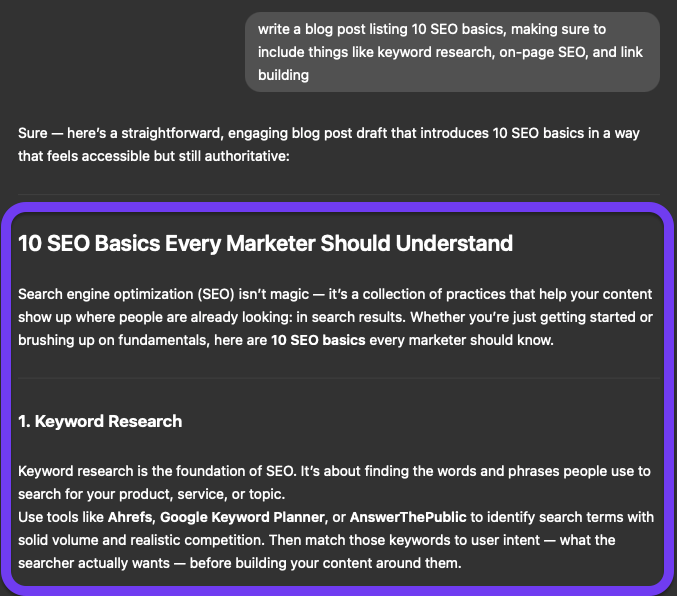
What’s happening here is the AI uses natural language processing (NLP) to interpret the input, tone, context, and intent behind the prompt, then produces content that feels coherent and human-like.
Sure, you might edit it later, but the original text comes from the AI itself—not your own writing process.
This is different from AI-assisted content, which usually means you are the writer, and the AI acts as a creative sparring partner. In that case, you’re using AI tools to:
- brainstorm ideas or headlines,
- create outlines or research notes,
- improve phrasing, grammar, or structure,
- or help refine your messaging.
This is something I do all the time when working in Surfer. I ask Surfy, the built-in AI writing assistant, to rephrase sentences, add examples, or adjust tone to polish what I’ve written:
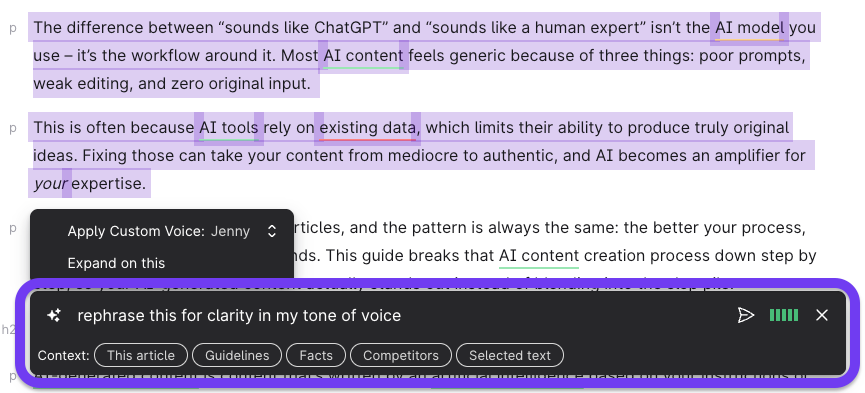
Why does most AI-generated content feel like “slop”?
Most AI-generated content feels like “slop” because it lacks nuance and originality. It’s dull, uninspiring and glaringly average. But this only happens because of weak inputs, vague prompts, and a lack of humans in the loop.
Weak inputs
If you don’t give AI a new perspective, it will just repeat the same tired ideas from its training data (other blogs, Reddit, Wikipedia, etc.). For it to create content of genuine substance and value, you need to feed it facts, data, real-life examples, and opinions.
Even just small efforts here can massively increase the quality of the output.
For example, I could just ask AI to “Write an article about the future of AI content,” but that’s a weak input because it lets AI wander into generic territory. However, if I feed it my opinion on the topic, it can write with a unique perspective.
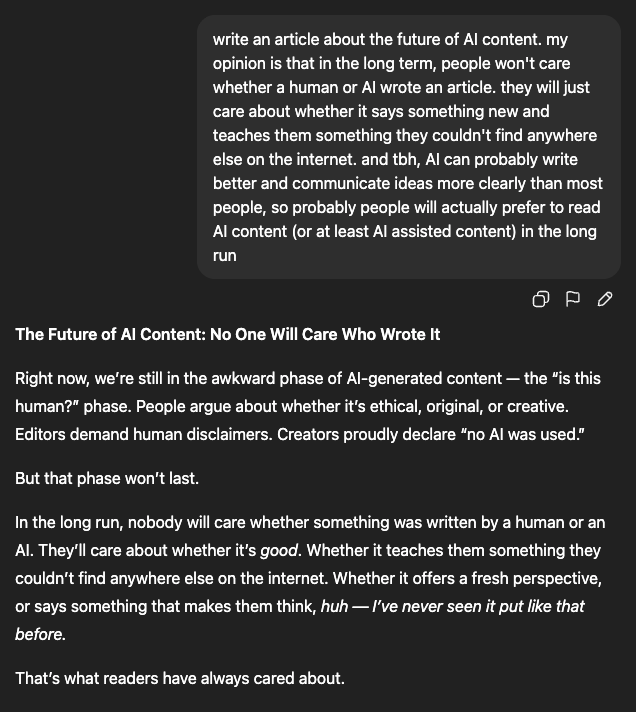
Here’s the full prompt I used:
write an article about the future of AI content. my opinion is that in the long term, people won't care whether a human or AI wrote an article. they will just care about whether it says something new and teaches them something they couldn't find anywhere else on the internet. and tbh, AI can probably write better and communicate ideas more clearly than most people, so probably people will actually prefer to read AI content (or at least AI assisted content) in the long run
You can see that the output doesn’t read like AI content because it takes a stance based on my opinion rather than recycling what’s already out there.
Vague prompts
Most people type “write an article about X…” into ChatGPT or Claude… and that’s where their input ends. This leads to fluffy and generic articles full of filler content—even if you feed it something original.
Why? Because this kind of prompt doesn’t specify a clear direction for the content. You’re leaving it up to AI to decide how to make the argument, which points are important and not-so-important, and what the conclusion should be. Nine times out of ten, when given this freedom, AI is going to make arguments you don’t agree with or that aren’t even true.
For example, although I fed AI my opinion, I just said to “write an article about the future of AI content…”:

Because of the fact it had the freedom to fill in the blanks, it made points I don’t agree with—like this one about how nobody will care about authors in future:
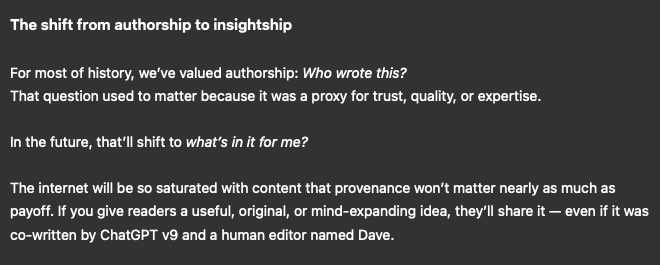
Preventing this from happening requires a more descriptive prompt that builds in guardrails and guidance.
Here’s what that might look like:
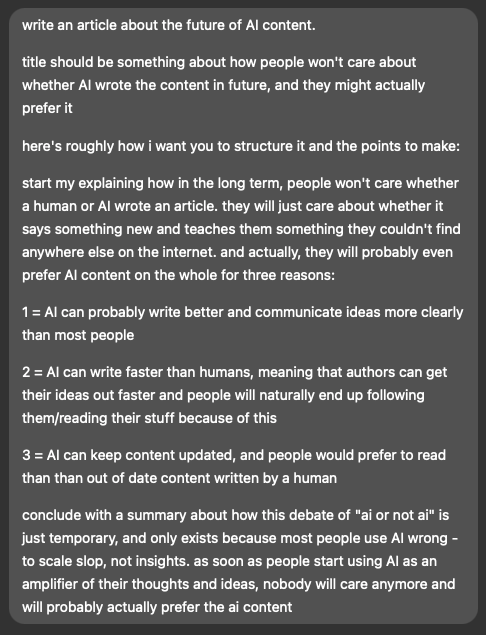
(Check out the output here, if you’re curious)
Yes, it’s long—but you can easily just dictate this to AI to save time. And the results are infinitely better than a vague prompt.
No human in the loop
If there’s no human touch, no wonder AI-generated content feels robotic. Often, AI first drafts get published exactly as they came out. That means there’s no fact-checking, no editorial judgment, and no refinement, just raw output.
It leads to all kinds of problems, such as:
1. Unchecked Facts
LLMs (Large Language Models) are designed to create plausible-sounding AI-generated text that makes misinformation get through the cracks. It often uses overgeneralization, for example, “SEO keywords are no longer relevant,” which widely oversimplifies the entire topic. Such seemingly small inaccuracies can easily turn into misleading claims.
AI generation can also cause hallucinations of facts, data, and statistics. For example, in May 2025, the Chicago Sun-Times and the Philadelphia Enquirer published a summer reading list including books that didn’t exist.

The reputational hit was huge, which is a great lesson on why you shouldn’t post AI content unchecked.
2. The flow feels clunky
AI-generated content is often made out of fragments of thought, not cohesive arguments. AI-generated text might be technically coherent sentence by sentence, but there’s no overall narrative arc. You can see repetition of the same ideas and awkward transitions.
For example, in a generated business report, you could see a sentence like this:
“In light of these variables, stakeholder synergy is paramount”.
The reader is left wondering: Which variables? How does that logically connect to the next paragraph?
The paragraph below is an example. It talks about mindfulness in very superficial ways and almost seems like a few sentences were combined into a paragraph without really flowing into each other.

You can solve some of these issues with less vague prompts (as I showed earlier), but AI still has a tendency to do this—so a human in the loop is paramount.
3. The “AI voice” and cliches
AI content generation is often characterized by unnatural, overpolished tone. The writing defaults to a bland, recognizable, and often verbose style that can hinder brand identity and readers’ trust.
You can easily recognize it by the use of cliches such as:
- Opening: "In the ever-evolving search landscape..." or "In the dynamic world of digital marketing..." (Instead of just: Search is changing quickly.)
- Thesis Statement: "It is crucial to note the undeniable importance of..." (Instead of just: This matters because...)
- Conclusion: "Moving forward, it is clear that we must embrace the paradigm shift..." (Instead of just: The next step is...)
For example, this article opens with the much derided phrasing “In today’s fast-paced world.”

Without the human writer to add valuable insights, personality, and a unique voice, AI produces content full of the worn-out “catchy” phrases.
How to generate AI content that’s actually good (not slop)
AI-generated content doesn’t have to be soulless. With the right prompts and editing, you can leverage AI to enhance your workflow and turn generative AI’s output into something actually worth reading.
Here’s how to do it right.
1. Research the topic and sketch a rough outline
Researching and outlining your article is one of the best ways to use AI to create content. If you don’t care about search engine optimization or showing up in answer engines like ChatGPT, you can simply ask AI tools this:
Research [topic] and create a detailed outline for a blog post, including key points, subtopics, and any important facts or statistics I should cover.
But if visibility matters to you, you need to dig deeper. That means researching what topics, keywords, and questions your content needs to cover to stand a real chance at ranking.
You can do this manually by combing through top-ranking pages on Google. But let’s be honest, that takes forever.
Here’s a quicker way:
- Go to Surfer’s Content Editor
- Click “New content” and choose the “Write yourself” option
- Enter your primary target keyword.
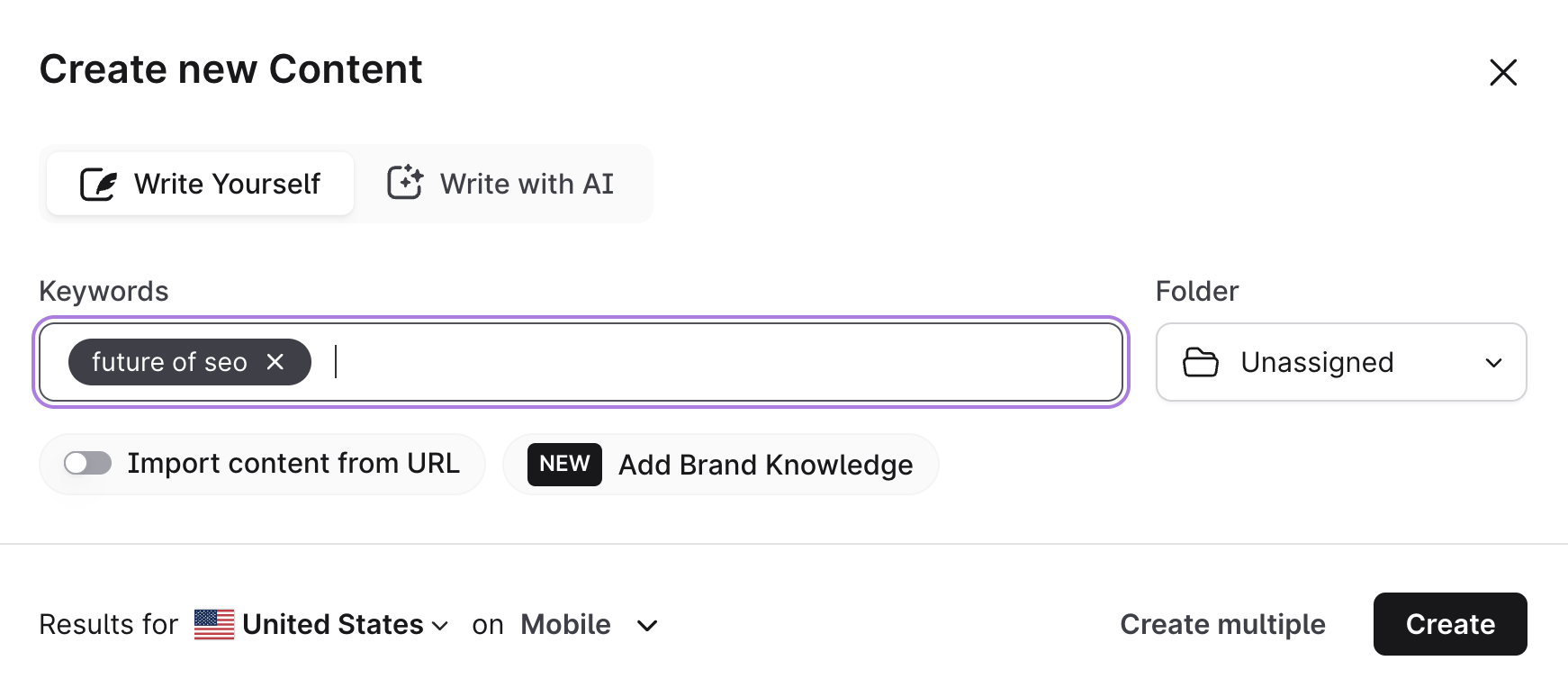
With the project set up in Surfer, click the “Customize” icon at the top right. You’ll see several options, but let's focus on “Competitors” for now.
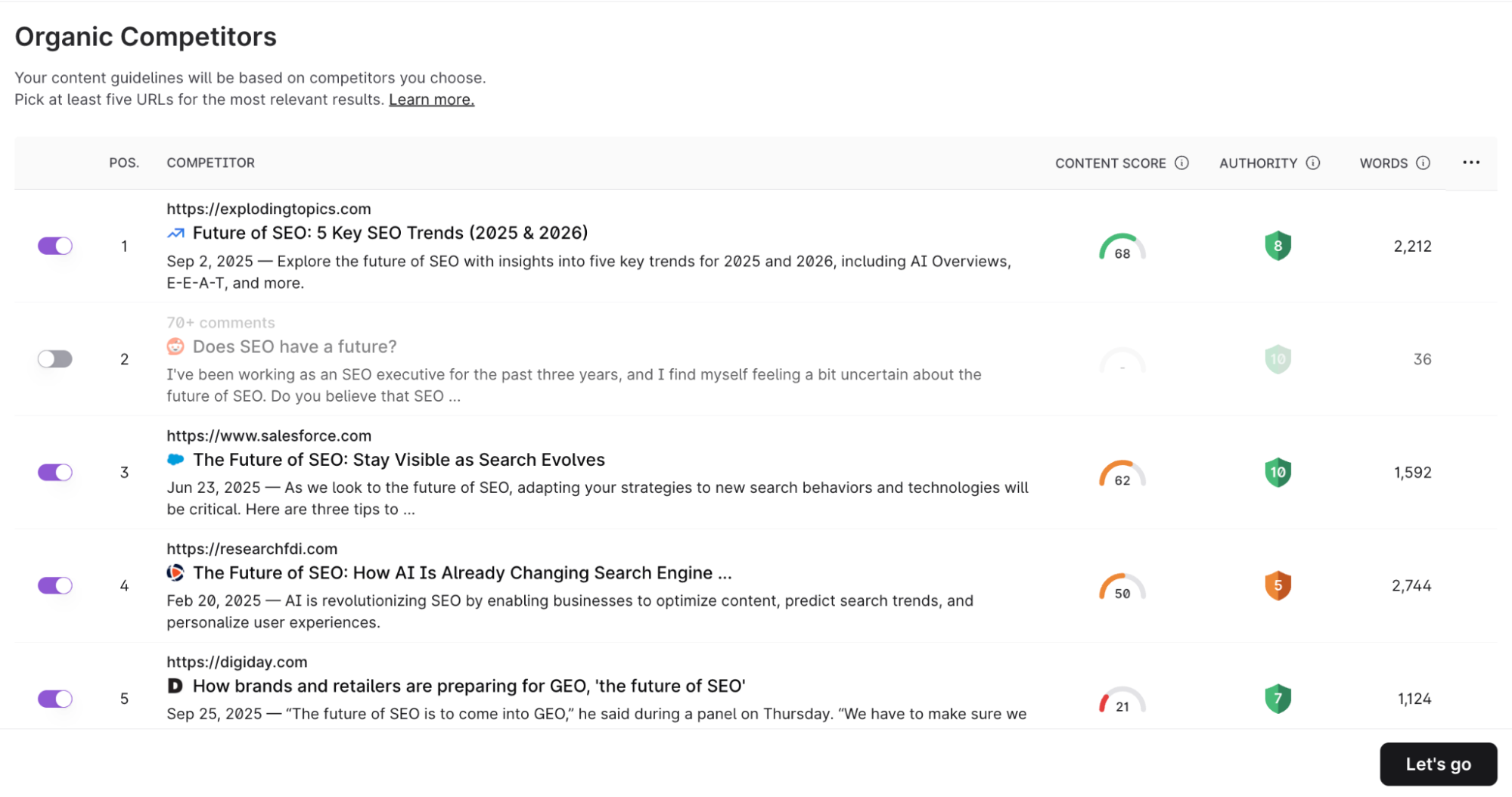
By default, Surfer selects the top 5 competitors with the highest Content Scores. This usually works well, but it’s worth reviewing the top 10 to add more data and make sure you're choosing the right competitors.
Check if your selected competitors:
- Match your content type. If you’re writing a blog post, exclude e-commerce product pages and service landing pages from your comparison.
- Share the same format. If you’re creating a listicle, compare it against other listicles rather than how-to guides or explainer articles.
- Actually rank because of their content. Look for competitors with high Content Scores and decent word counts. If a page only has a couple of hundred words but ranks well, it's probably coasting on domain authority.
Once you’re happy with your choices, click “Let’s go”.
Now, if you go to the “Outline” tab, you can see all of the subheadings your competitors use in their content:
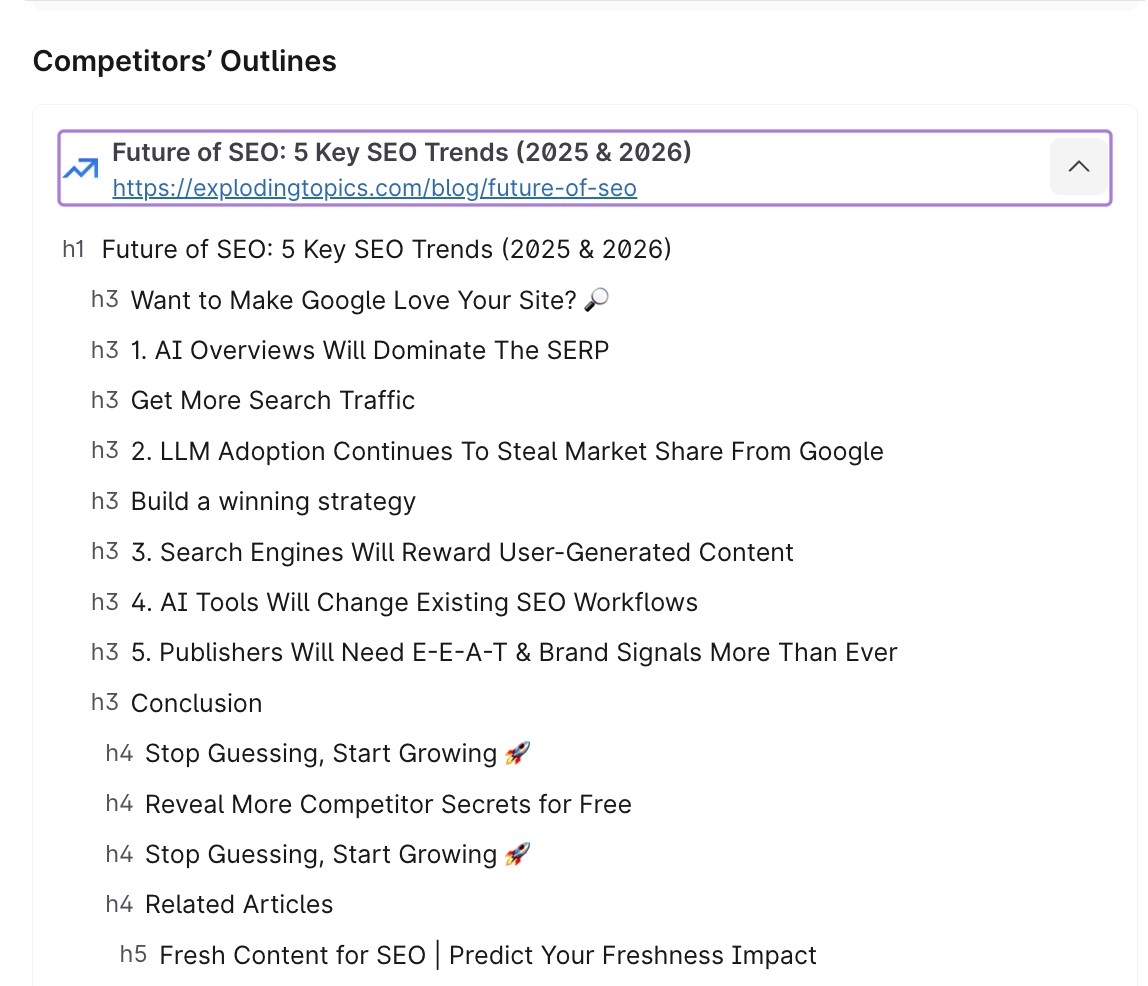
What I do here is skim through them and copy-paste any points or angles I might want to cover into the Content Editor.
If this feels like too much work or you're not sure what to include, just click “Insert outline" and Surfer will instantly generate one for you using generative AI.
2. Add original input that only you can provide
This is the most important step in creating content with AI. Without adding original thought or input, you’ll end up with an article that repeats what everyone else has already said, often resulting in generic AI-generated materials based solely on existing data.
So this is where you need to give AI tools some insights to work with. One way to do this is to come up with a thesis, an argument you want your article to revolve around.
For example, the thesis of this post is clear: AI-generated content only feels generic because of poor prompts, weak editing, and a lack of original input. But, with the right workflow (which we’re going through right now), AI tools can actually amplify your expertise instead of producing another pile of slop.
How to form a thesis? Look at your outline and ask yourself what you personally believe about the topic—what opinions do you have? This is how I came up with my thesis.
You can also research your audience’s opinion on that very topic. Go through Reddit or Quora, or simply ask your audience about their “hot takes” on social media. This may not only help you refine your own opinion but also confidently present counterarguments in your content.
Here’s an example of a poll, which is a part of Graphite’s article about AEO, GEO, and AI SEO and how this new field should be called.

Such polls are great to publish on social media to ask your audience about the topic you feel they will connect with.
You can also interview or survey experts, like Semrush did in their study about how AI-generated content performs in Google.
Here’s one of their questions:
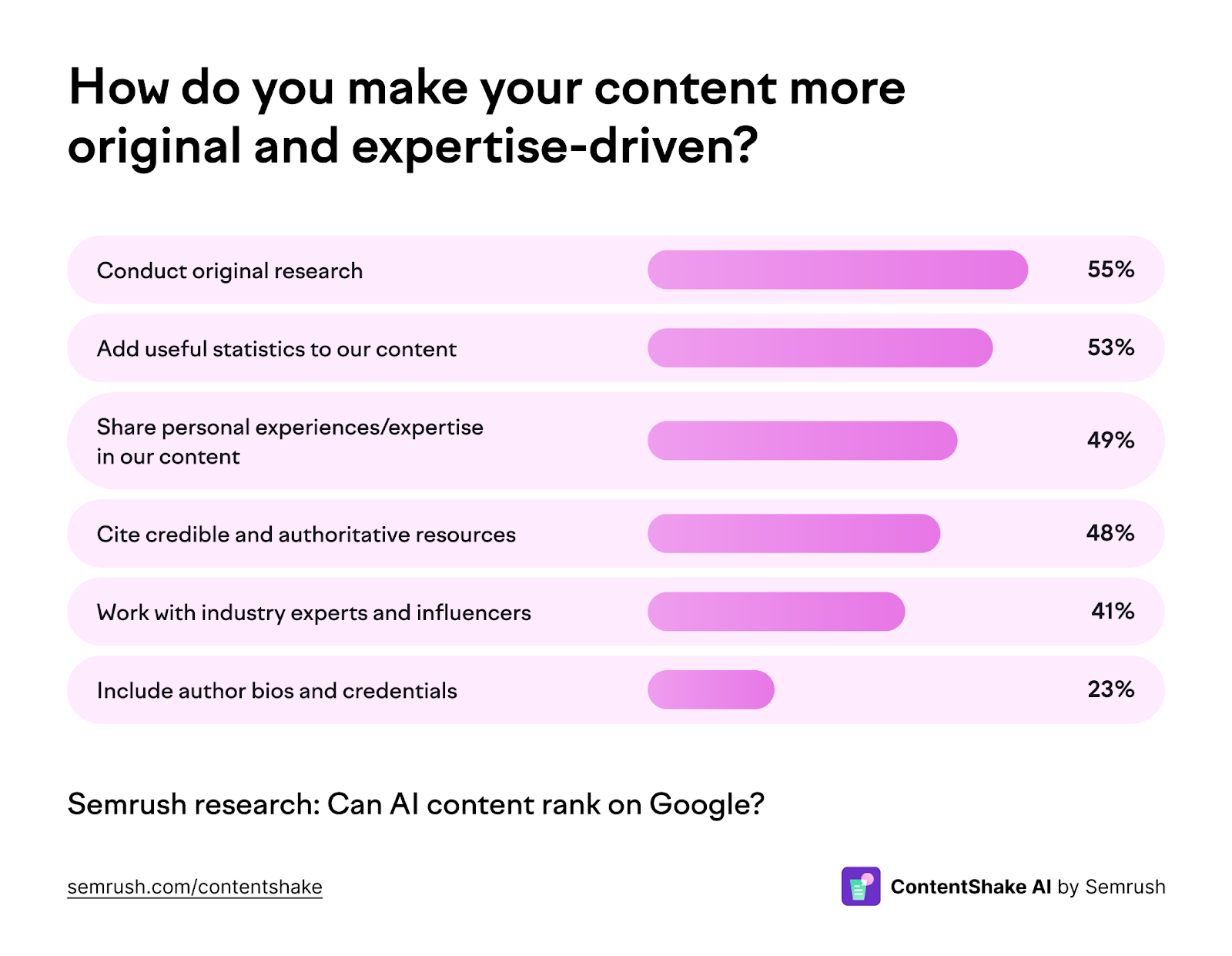
Or, you can feed AI the results of in-house studies or experiments that gave you proprietary data…
For example, the Surfer team ran an experiment where we created an article targeting “best free AI detection tools” and got it cited in Google’s AI Overviews and AI Mode in 24 hours. This showed that when your content perfectly matches search intent and is clearly structured, Google’s AI is much more likely to pick it up.
This is something we could feed to AI if we were creating AI-generated content about “How to rank In AI search,” for example.
If you’re coming up blank and aren’t sure, try asking AI. It might not come up with an incredible idea immediately, but it’s usually a great sparring partner.
In Content Editor, you can ask Surfy to add unique ideas right in the subsection of your outline. For example, here’s an article about how to learn to play guitar with Surfy’s suggestions for the subsection:
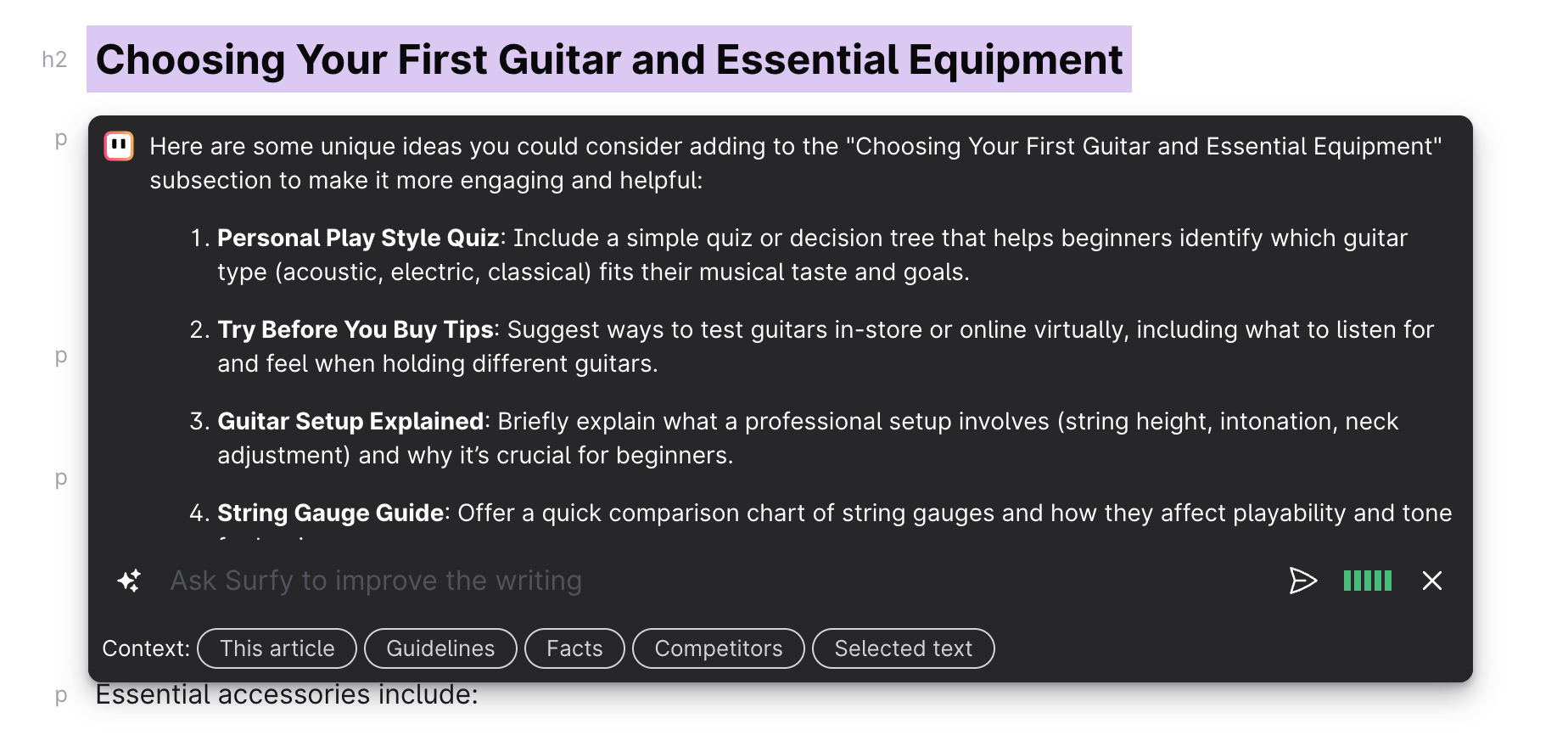
3. Draft your content with AI using a clear voice and constraints
At this stage, you could just hand your outline to AI tools and say, "turn this into a full draft," but that's lazy prompting, and you'll get lazy results.
To get something actually worth publishing, you need to start AI content generation with clear guidance on how you want it written. The most important element? Your tone of voice.
If you’re using Surfer, you can adjust your tone of voice by clicking the three dots in the content editor, clicking “Surfer’s voice (SEO expert)”, and clicking add new voice.
Here you can give guidance on the tone of voice you want, like this:
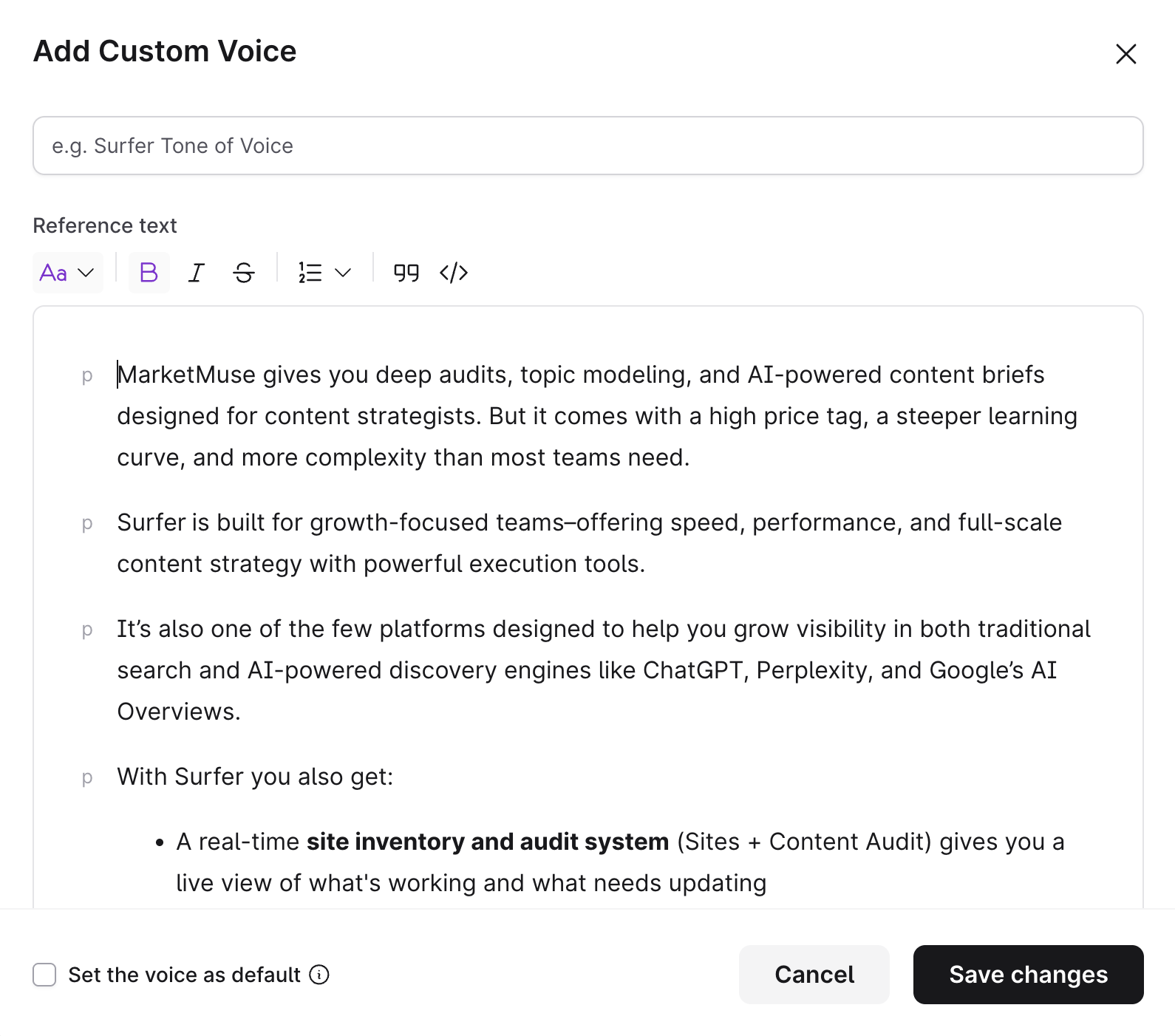
If you don’t know how to describe it, here’s a neat trick. Go to ChatGPT and paste in this prompt, along with an article with a tone of voice you love:
“Analyze this content's tone of voice, and give me a list of bullets I can feed into an LLM to help me replicate it across other articles. I don't want anything other than a simple list of bullet points.”
Then just copy and paste this into Surfer and save it as a custom voice.
Then you can go back to the editor, highlight the outline, and ask Surfy to “draft the full article based on the highlighted outline”.
If you prefer to work section by section, just do the same thing, but highlight a section at a time and ask Surfy to “draft this section based on the outline.”
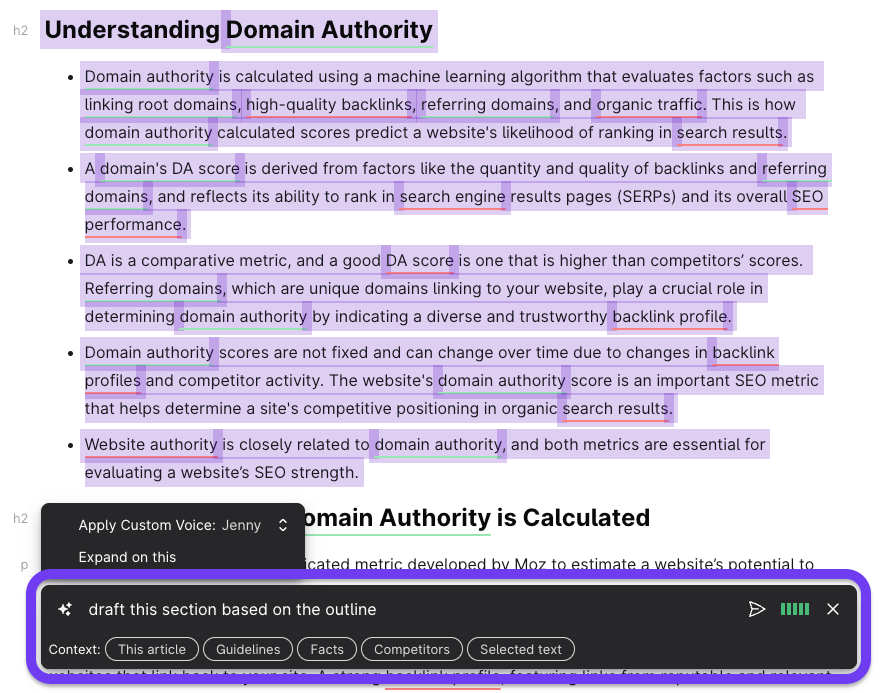
If your content score’s still low, add an FAQ section using questions from the outline pane, or hit Auto-Optimize to fill in missing terms. You can also boost fact coverage to increase your chances of getting cited in LLMs. Paste in relevant facts yourself or let AI handle it with the Boost Coverage button to improve your chances of being cited in LLMs.
4. Line‑edit the draft with AI to sharpen truth and clarity
Editing is a skill on its own, so you should add a human in the loop to truly refine your AI-generated content. Involving human content writers helps address quality concerns, and uphold ethical considerations in the editing process.
That said, I think it’s super helpful to let AI tools handle minor edits upfront so you’re providing your human editor with the best possible starting point. However, always be mindful of ethical concerns and the limitations of AI-generated work, as unchecked AI-generated materials can introduce errors or bias.
Here’s the prompt I use for this:
Your task is to line-edit this content according to the instructions below. Do not change any of the subheadings and don’t mess with the overall structure of the post and what’s being said. You should make small line edits only to polish the copy.
Here are the instructions:
Run a specificity sweep to replace vague terms with concrete nouns and precise verbs.*
- Tighten noun–verb phrases by collapsing bloated constructions into a single strong verb.
- Convert passive sentences to active voice wherever the actor is clear or implied.
- Replace generic transitions with content‑rich bridges that summarise the shift in idea.
- Detect and remove mixed metaphors and cap figurative language to one clear device per section.
- Enforce one‑idea‑per‑paragraph and align headings to a consistent parallel structure.
- Vary sentence lengths to balance punchy lines with longer, explanatory sentences.
- Strip “AI‑voice” tics by removing hedges, cliché X→Y flips, filler, emoji crutches, and excess em dashes.
If you’re using Surfer, just highlight your content and ask Surfy to do this. Or, you can paste these instructions straight into the AI tool of your choice.
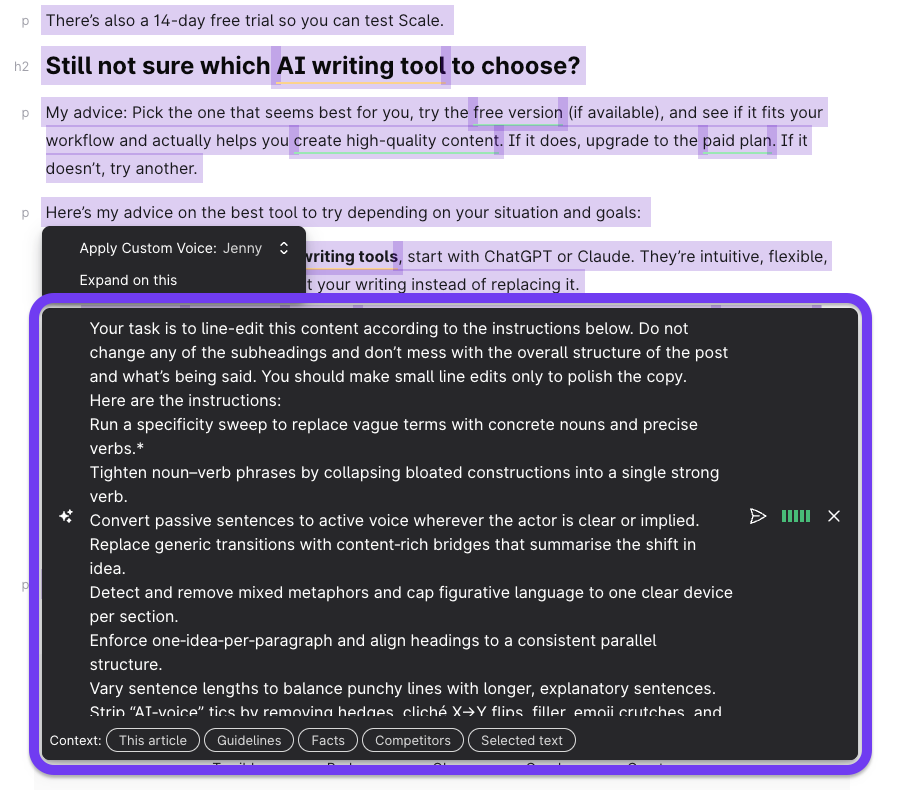
From here, you can give it to your human editor to check things and polish it to perfection, ensuring the final result meets high standards of quality and ethical considerations.
5. Prepare for publishing (with AI’s help)
Your content is written and polished. Now you need to link it properly and get it in front of people. The good news? Generative AI can handle the heavy lifting for both, including optimizing internal links to your existing content and preparing it for distribution.
For example, if you’re drafting in Surfer’s Content Editor, you can click the “Insert internal links” button in the toolbar.
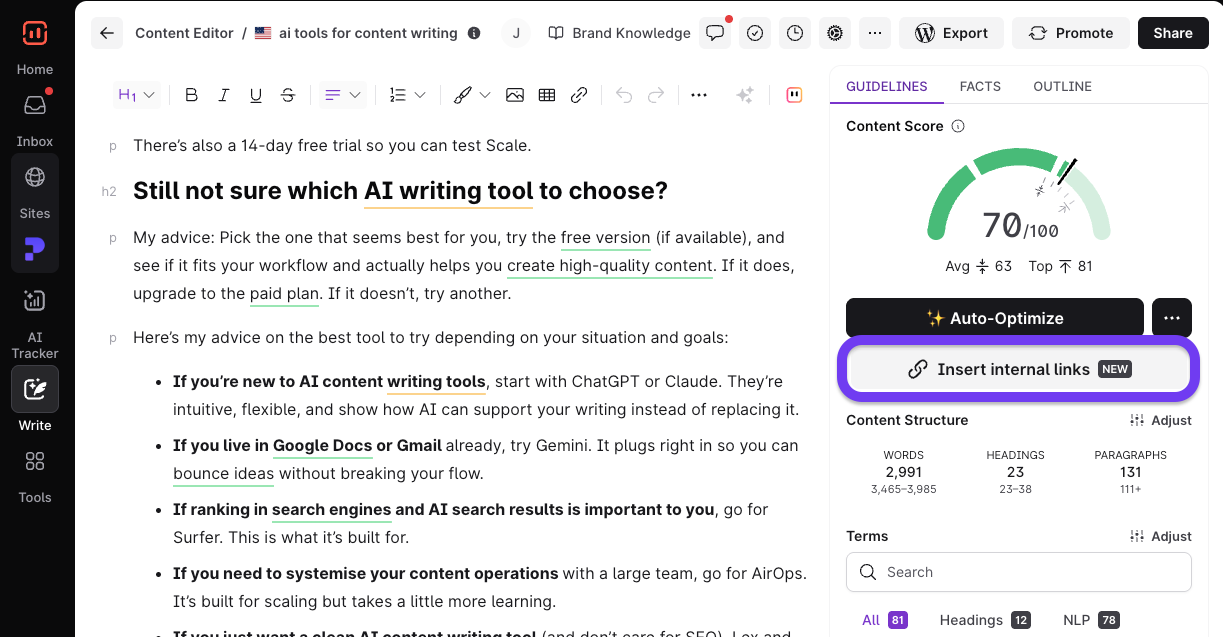
Surfer will automatically scan your content and suggest relevant internal links from your existing content, complete with optimized anchor text. Review the suggestions, accept the ones that make sense, and you’re done.
If you don’t use Surfer, search Google for site:yourdomain.com [topic keywords] to find relevant internal linking opportunities from your existing content, copy the URLs and titles, and feed them to ChatGPT with your article and this prompt:
“Here are existing posts from my site [paste list]. Review my article and suggest where to add internal links to these posts, including specific anchor text recommendations.”
Now for distribution…
If you’re using Surfer, you can click the “Promote” button at the top of the editor. Surfer will analyze your content and generate ready-to-post social media posts tailored for different platforms—LinkedIn, Twitter, Facebook, and more.
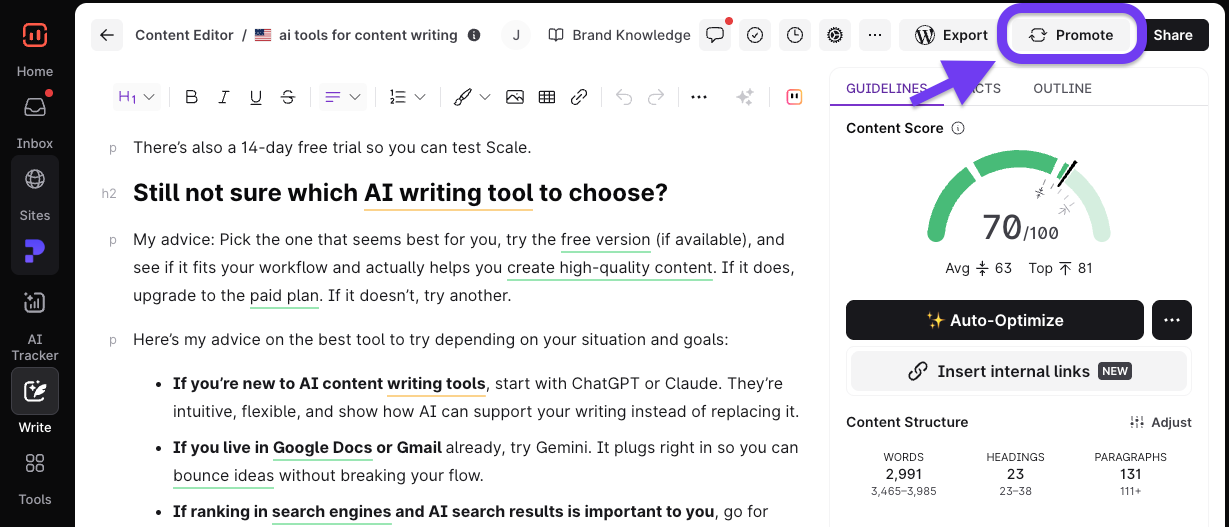
(You can also leverage AI to create short-form content, marketing materials, and ad copy for broader promotional reach.)
If you’re not using Surfer, copy your article into ChatGPT/Gemini/another AI tool and ask:
“Create social media posts for this article tailored to [LinkedIn/Twitter/Facebook]. Write 3 variations for each platform with different hooks and angles.” You’ll get a batch of promotional AI-generated content in seconds, including short-form content and ad copy.
Just remember to check the suggestions, tweak the tone to match brand voice, and either schedule them directly or copy-paste them into a social media scheduler.
And of course, if you prefer to write your own promotional content, that’s fine too. But having AI generate content serving as the first draft saves you from staring at a blank text box for each platform.
It’s time to stop the slop
Everyone’s generating AI slop these days, including your competitors. The way to beat them isn’t to join the race to the bottom.
If you really want to stand out and build your brand in a sea of sameness, you need to use AI for content creation differently. Not to scale “content” for the sake of hitting arbitrary publishing quotas, but to scale content that actually matters.
The workflow we’ve covered here is meant to amplify what you already know and help you say it better, faster, and more clearly. As you use AI, remember to keep ethics and quality front and center to keep quality consistent.
That’s the difference between content that gets lost in the noise and content that people actually remember, share, and come back to. Use AI as a tool to scale your expertise, not replace it.



.avif)



